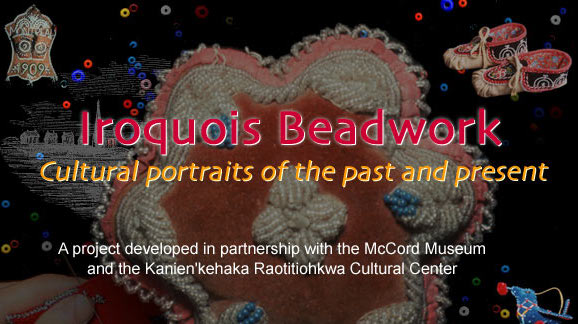
For the Iroquois Project General Overview, Curricular fit, Background information, the Origin and Evolution of Beadwork and more about Styles of Beadwork, read way way below!
Iroquois Learning Scenarios (Units and Activities):
NOTE: The links to our old site below might be broken. You can also browse through this PDF version to view the activity ideas!
Unit: L’histoire des Premières Nations racontée par les écoliers
A unit designed by Johanne Ethier
Joliette Elementary School, Sir Wilfrid Laurier School Board
Unit: Learning about the Iroquois – a project-based approach
A project developed by Barbara Vaupshas
Holy Rosary School, Sir Wilfrid Laurier School Board
Activity: “Used-to-be’s”
An activity designed by Robin Delaronde
Kateri School, Kahnawake
Activity: “Used-to-be’s”
A project developed by Barbara Vaupshas
Holy Rosary School, Sir Wilfrid Laurier School Board
Activity: “Exploring your views – Expanding students’ knowledge about people of First Nations”
An activity designed by Johanne Ethier
Joliette Elementary School, Sir Wilfrid Laurier School Board
Activity: “Mohawk/Kanien’kehaka Creation Story”
An activity developed by Shelly Goodleaf McComber
Kateri School, Kahnawake
Activity: “Children Meeting Children – A cultural exchange”
An activity developed by
Shelly Goodleaf McComber from Kateri School, Kahnawake
and Pat Davies from Bancroft School, English Montreal School Board
Activity: “Beaded Bird”
An activity designed by Robin Delaronde
Kateri School, Kahnawake. (presently KEC Director of Education)
Iroquois Beadwork: General Overview
What initiated the project?
The project was initiated when Ann Cohen, pedagogical consultant at Sir Wilfrid Laurier School Board, toured the Across Borders Iroquois Beadwork exhibition at the McCord Museum in 1999. She realized that teachers were going to be in great need of gaining their own knowledge about First Nations and that there was going to be a need for materials for the implementation of the new History, Geography & Citizenship Education Program. She approached the director of the McCord Museum and Deborah Gross at the Services à la communauté anglophone with her idea.
A team of educators was formed and we’ve been working on the project ever since. Donna Boychuk co-ordinated the group, Christine Truesdale designed and developed the website, Robin Delaronde, Shelly Goodleaf-McComber, Pat Davies (1999-2000), Johanne Ethier (1999-2000), Barbara Vaupshas (2000-present), were the action-research teachers, and Ann Cohen was the educational consultant.
What is the project?
The project consists of a number of learning scenarios that teachers can use in their classrooms. However it is not a step by step lesson plan. Our team created, developed, tried out the scenarios in their specific classrooms and revised and adapted as the learning took place, in much the same way that any good teaching occurs. To use any of the learning scenarios and material resourcesResources are anything taken from the earth or nature that people need, use, and are "valued".... suggested here would require that as a teacher of your particular students, you do the same. Try out adapt, change, add to and recreate your learning scenarios to fit your classroom and your students. These scenarios require tampering and medling on your part. It is in this constructionConstruction - The process of building something or putting something together Construction - Le processus de... and reconstruction of the learning environment that we can create and recreate significant and meaningful activities for our students and assist them in the acquisition of competencies.
| Cycle | Subject Areas |
| 1-2 |
|
| Cross Curricular Competencies | Broad Areas of Learning |
|
|
Curricular fit
Certain Basic Principles to Remember…
Socio-constructivism
There are, however certain basic principles to remember. You have probably heard these over and over again throughout the implementation of the reform. All of the learning scenarios are to be constructivist in nature and moreover they are designed to be socio-constructivist. If they sometimes fail in this, we are sure that you will reconstruct the learning scenarios. There are some questions that we may ask ourselves as teachers to lead us more closely in creating socio-constructivist learning scenarios for our students. The focal point of all student learning in the QEP is the constructionConstruction - The process of building something or putting something together Construction - Le processus de... of his/her World-View:
The development of a world-view, which is related to the sense of judgment and conscience, is fostered by reflection on the great existential issues (life and death, love and hate, success and failure, peace and violence, etc.). It also depends on the extent to which students are willing to compare their world-view with those of others and to look critically at themselves and their actions, reactions, opinions, beliefs, values and attitudes. (QEP, p.11)
With this in mind, the questions might be directed in the following manner:
Are my students examining their initial views of the Iroquois society?
Are they evaluating where these views come from and how they were formed? i.e. what influences their views
Are my students continually reevaluating these views?
Are they exchanging ideas and viewpoints?
In contexts of discussions (penpals, e-mail, videos…) with others of this society are they celebrating the differences and similarities to their own lives?
Are my students having many opportunities to discover ideas, take positions and express them?
Do my students have occassions when they are asked to consider the way that they are constructing their views and perspectives?
Are they given chances to observe facts, situations and events from various viewpoints?
Are they given opportunities to compare viewpoints with their classmates so as to develop their critical judgements?
Are they given chances to test their model of the world against that of others?
For these types of socioconstrutivist learning scenarios to develop our students must :
- become aware of their opinions and attitudes
- reflect on their experiences and those of others
- discuss ideas
- form and then reformulate ways of going about learning
The learning scenarios need to ask students to find relevant information;organize it; use, present and evaluate procedures; analyze problems and make attempts at finding solutions as well as evaluating steps taken; develop plans, create procedures and reflect upon these; interact with others and evaluate these interactions; plan tasks with others and evaluate products, interactions and procedures. These socioconstructivist designs are entrenched in metacognitive activities. Learners need to be in continuous phases of exploration, constructionConstruction - The process of building something or putting something together Construction - Le processus de... and reflection. The examining of what we know and how we go about knowing is not new but the time we have our children involved in these activities are. It’s just a fact of any pedagogy, especially a socio-constructivist pedagogy.
Cross-curricular
The learning scenarios are cross-curricular and should encompass these competencies above all. These are in fact the basics and the reason for having scenarios in the subject domain such as this one- History, Geography and Citizenship Education.
The learning scenarios need to embed :
- using information
- solving problems
- exercising critical judgement
- being creative
- using effective work methods
- using information and communication technology
- developing personality
- working with others
- communicating
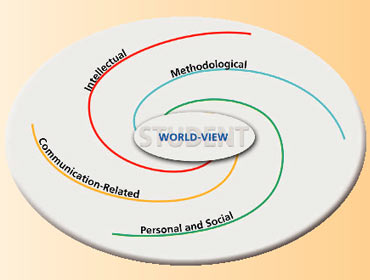
Source: QEP, p.13
For example, as students are learning to represent change and events on a timeline, they might explore a variety of ways to represent the passing of time and recording of events. The activity is thus placed in a problem solving context. Planning their timeline, choosing materials and continually entering into dialogue with peers and teacher would develop methodological competencies. Representing this information in a visual and / or media text as well as communicating elements of the process and the product would develop competencies in both cross-curricular and subject domains.
Other ways of representing information by posters, bookmarks, art, music, dance, drama, writing, graphing, etc. can be explored in the learning scenarios that you create. The cross-curricular competencies of problem solving, using information, communicating, using technology, etc. are to be at the core of these learning experiences and in our evaluations of this learning.
Evaluation
Both you and your students need to determine what criteria will determine which competencies and to what extent they have been achieved. For this evaluation and self-evaluation to take place requires planning before the actual activities begin. Children need many opportunities to reflect upon their choices that they make throughout the activities as well as the products that they create. Placing children in situations where they have to present and describe their work, and defend their ideas affords them occassions to get perceptions of what others see in the work that they’ve done. This reflection can bring about revisions-that which is imperative in the learning process.
Children reflect upon their learning as we place them in activities that ask them to look back on their work in authentic workshop style.
How did you do that? What did you mean by…?
Are some things you would do the next time you did that kind of work?
These are a few questions that lead to this reflective learning and evaluating.
Coining the Concept of ‘RE’
After having many discussions with teachers over the past year regarding the concepts of the reform, I have come to a landing on a particular concept that I have decided to coin as the ‘ RE‘ concept. Over the past twenty years teachers have designed themes, units and learning activities for chidren that have delighted, informed and taught them. In a one year time span and with so many programs, texts, and materials to ‘cover’ it seemed difficult to return to concepts and skills to review, revise, reconsider and reconstruct – that which is at the heart of the now two year cycle of learning. In all of the learning scenarios offered in this project it will be essential to include this concept of ‘ RE‘. Those that know me will be familiar with this next statement. As much time that is given to the actual activity is as much time that will be required to relook, reevaluate, reflect, redesign, recontruct, and reaffirm notions, ideas, skills, concepts, understandings and knowledge.
Starting From the Child
Starting from the child is in no way a new concept for teachers and in the context of the on-going devlopment of World-View it is especially pertinent. Our students can be lead to understanding the whole notion of history from their own histories or as we call it in our learning scenarios ‘used-to-be’. Adding their parents and grandparents histories provides personal connection and significance while children create a timeline of their and their families’ past. Involving the children in constructing their knowledge of their past, connecting it to their parents and then their grandparents will assist these young children in their understanding of timelines and historical change. Children might then begin to explore other societies and their relationship to change.
Background information
It’s important to remember that in Québec alone, there are eleven recognized Indigenous Nations. There are ten First Nations – W8banaki (Abenaki), Anishinabeg (Algonquin), Atikamekw, Eeyou (Cree), Wendat (Huron), Wolastoqiyik Wahsipekuk (Malecites, Maliseet), Mi’kmaq, Kanien:keha’ka (Mohawk), Naskapi, Nitassinan (Innu)– the eleventh Nations is the Inuit.
It is best to use each nation’s self-identified name. The name(s) that English and French settlers have used to refer to each Nation are in brackets. We encourage you to use and teach others the self-identified names of the 11 Nations with communities in the province of Quebec.
The 1996 CensusA questionnaire or survey of an area to find out how many people live there enumerated 71,415 Indigenous Peoples in Québec, or 9% of Canada’s Indigenous populationPopulation comes from the Latin populus, meaning “the people.” We say population when we talk about a group.... However, it should be noted that several large reserves in Québec were not enumerated in this CensusA questionnaire or survey of an area to find out how many people live there. Indigenous Peoples accounted for only 1% of Québec’s total populationPopulation comes from the Latin populus, meaning “the people.” We say population when we talk about a group.... According to the 1996 censusA questionnaire or survey of an area to find out how many people live there, Québec’s Inuit populationPopulation comes from the Latin populus, meaning “the people.” We say population when we talk about a group... of 8,300 is the second-largest in the country, representing about one-fifth of the total Inuit populationPopulation comes from the Latin populus, meaning “the people.” We say population when we talk about a group....
Here is a 2023 map of Indigenous Communities in Quebec, produced by the Government of Canada:
https://www.sac-isc.gc.ca/eng/1634312499368/1634312554965
Many Indigenous Nations in Québec and the rest of Canada have long practiced beadwork, including two Iroquois nations in particular, the Kanien:keha’ka (Mohawk), with communities near ‘Montreal’, and the Tuscaroras, who live on the American side of Niagara Falls. The McCord Museum exhibition – Across Borders: Beadwork in Iroquois Life – that inspired this project is based mainly on the beadwork of these two nations. This website focuses on the beadwork of members of the Kanien:keha’ka (Mohawk) community in Kahnawake.
Haudenosaunee ConfederacyThis is a group of people or nations or tribes or provinces that form an "alliance"....
Iroquois, Six Nations ConfederacyThis is a group of people or nations or tribes or provinces that form an "alliance"...., People of the Longhouse, Haudenosaunee…these are all terms used to identify six First Nations who have lived in northeastern North America for countless generations. The Kanien:keha’ka (Mohawk), Oneida, Onondaga, Cayuga and Seneca came together for mutual support. They were joined in the 18th century by the Tuscarora. Traditionally an agricultural people, the Haudenosaunee tended to occupy relatively permanent villages surrounded by fields of corn, beans and squash – crops known as the Three SistersThe Three Sisters are the three main foods grown by various indigenous peoples in present-day North....
The arrival of the Europeans profoundly changed traditional ways of life. For example, Europeans brought diseases which infected and killed many Indigenous Peoples. At times, entire villages were displaced by Europeans. Europeans also tried to convert many Indigenous Peoples to their spiritual beliefs.
Today, Indigenous Peoples continue to live across Turtle Island. There are many initiatives to revitalize Indigenous languages and teach traditional ways of knowing and doing to youth.
This website focuses primarily on the Kanien: haka (Mohawk) community of Kahnawake, situated southwest of Montreal, which has a long history of making and selling beadwork. There is a lot of diversity amongst Indigenous Nations and we encourage you to learn more about Indigenous communities in your local area and across Turtle Island.
The Haudenosaunee World View
For the Haudenosaunee, the traditional concept of the universe is inspired by their intimate relationship with the environment. This worldview is handed down from generation to generation through the telling of stories. One important story is that of the Creation. Here is one version of a creation story, as told by Shelley Goodleaf-McComber, a teacher at Kateri School in Kahnawake and Corissa, Jarrod, Jay, and Devin, who are students at the school.
The origin of beadwork
Wampum Belts
Historical memory, transmitted via oral traditionOral tradition is where knowledge, art, ideas and cultural material is received, preserved and transmitted from..., was preserved in wampum belts. These examples were made by weaving small cylinders made out of white and purple shells. These shell beads could also be used to make personal finery and we often find them in the form of belts made to commemorate certain events and to confirm agreements. Wampum belts were thus very important to the Iroquois.
The guardian of the wampums was the protector and the teller of the stories written within the wampum belts. However, events and time have sometimes blurred their significance, as in the case of the so-called “wampum with the two dogs,” which dates from the end of the 1700s. We believe, though we are not certain, that it is linked to the Kanasetake (Oka) territoryA territory is an area of land, or sometimes of sea, that we can say "belongs".... Purple wampums were rarer and more valuable than the white ones. Thus, wampums, where purple is the dominant color commemorate an event or an agreement of great importance.
Including wampum belts in an exhibition is both rare and controversial. This particular wampum belts is displayed with the permission of the Iroquois of Kahnesatake. In the United States, the Iroquois nations are opposed to the public exposition of wampum belts, as they consider them to be sacred. Since this exhibition will be travelling to the Tuscaroras Museum (on the American side of Niagara Falls) as well as to the American Indian Museum in New York, this wampum belt will no doubt provoke a great deal of debate.
The evolution of beadwork
Before the arrival of glass beads, the people of First Nations decorated their objects and clothes with materials found in their own environment, such as stones, shells, plants, porcupine quills, moose hair, and feathers. An example of this can be seen in these moccasins, where the geometric patterns are formed with dyed porcupine quills.
The origin of glass beads
The arrival of the Europeans meant the introduction of new materials in the decoration of Iroquois objects, namely glass beads.
Why were glass beads shipped to America?
European merchants used them as currency in the fur tradeTrade is when we buy, sell, or just exchange goods (things, foods, etc.) or services (helping... with the First Nations. One kilo of glass beads was equal to one and one-third beaver belts. In this way, millions of beaver skins were exchanged for glass beads.
What did the Europeans do with the beaver pelts?
Felt, made from the shorter hairs of the beaver fur, was used to make top hats, which were in fashion for over 200 years.
The beads were made in Venice, Italy. In order to monopolize the tradeTrade is when we buy, sell, or just exchange goods (things, foods, etc.) or services (helping..., the Venetians guarded jealously the secret of how to make glass. Glass was – and is – made from one principal element: silica. Silica is found in the sand and quartz at the bottom of rivers. In order to make glass, other materials such as cobalt and pieces of ground glass are added to the silica. This mixture is then heated in a large oven until it becomes a thick, red-hot paste.
In those early days, glass beads were made by shaping the paste into a ball. Then, using a long, hollow iron tube like a straw, an air bubble was blown inside the ball. After attaching an iron tube to each side of the bubble, two workers would run in opposite directions, each holding on to one of the tubes. In this way, the hot glass would itself become the shape of a tube, which would then cool and begin to harden before it had a chance to touch the ground. Before the glass got too hard, it was into a myriad of small pieces, each of which had a hole in the middle, because of the space left by the air bubble inside the paste.
Once they had properly hardened, the small pieces of glass were put into large wooden barrels containing sand or bran (the husk of wheat kernels). By rolling these barrels, the artisans were able to soften and round the shape of the glass beads. The beads were then slipped onto long threads, which were later bundled together, ready for shipping to the newly discovered territories: Africa, South America, and here in North America.
For more information about seed beads, you can visit the following website:
The Bead Site – Seed Bead Gallery
http://www.thebeadsite.com/mussb-01.html
Iroquois worldview (see Creation story)
Styles and techniques of beadwork
| Over the ages, the art and techniques of beadwork have changed, but they have been handed down through many generations of Iroquois and are still an important traditionTradition- A tradition is something that has been done in a community or a culture over... today. Linear Style | |
This bag is an example of the linear style, where the beads form lines. This style is inspired by early work using porcupine quills.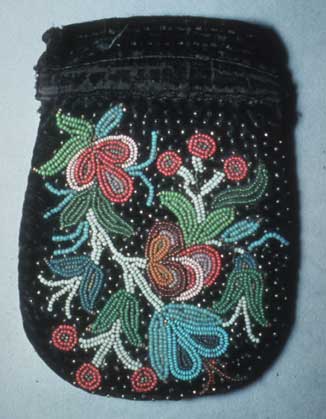 | |
| We find straight lines, curved lines, geometric designs and borders. The lines most often trace the shape of flowers, hearts, suns, and, occasionally, animals and people. The designs on these objects are of flowers and plants in pastel colors. Different colors are used to reproduce the shadows. At the centre of beadwork flowers, we often find a stylized flower with tapering petals. A hundred years ago, these objects were refined commodities, highly appreciated by Euro-North Americans and tourists, for whom the Iroquois made them. This particular style corresponds to a strong fashion and taste for nature in all its forms. | |
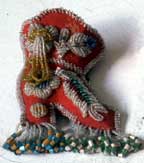 | 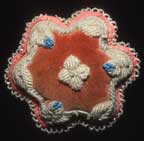 |
| White on red beadwork A little more than a hundred years ago, Tuscarora artisans invented a new style of beadwork by sewing opaque white and transparent beads onto red velvet. They made all sorts of souvenirs, such as pincushions, needle-cases, doilies and amts, for tourists to buy when they visited Niagara Falls. Why were the pincushions so popular a hundred years ago? At that time, all fashionable ladies wore hats, which were held in place with a long hat pin. When a lady went indoors, she would re-move her hat, placing the pin in the pincushion conveniently sitting near the door. | |
| Flat multicolored beadwork
| |
 | |
Flat multicolored beadwork is a style that became popular during the second half of the 1800s. We can recognize it by the flower and leaf designs in red, blue, gold, and green. In those times, tourists who visited the Kahnawake and Tuscarora reservations bought vast quantities of little bags, frames and other objects, decorated in this style of beadwork.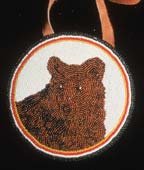 | |
| Raised beadwork
| |
The most 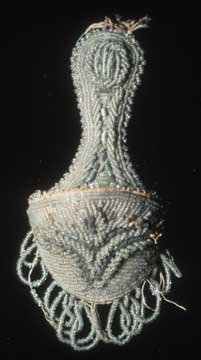 spectacular of all the styles is raised beadwork. Perfected by the Mohawk and Tuscarora women, this technique consists of sewing several rows of tiny, translucent beads in such a way as to create a three-dimensional shape. Large beads, as well as multi-facetted tubular beads, add to the richness and brilliance of the work. Birds, foliage, and berries are formed in relief on the surface of the fabric. The cardboard patterns also served as a lining and support for these beadwork masterpieces. spectacular of all the styles is raised beadwork. Perfected by the Mohawk and Tuscarora women, this technique consists of sewing several rows of tiny, translucent beads in such a way as to create a three-dimensional shape. Large beads, as well as multi-facetted tubular beads, add to the richness and brilliance of the work. Birds, foliage, and berries are formed in relief on the surface of the fabric. The cardboard patterns also served as a lining and support for these beadwork masterpieces. 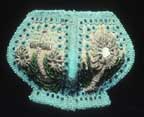 | |
